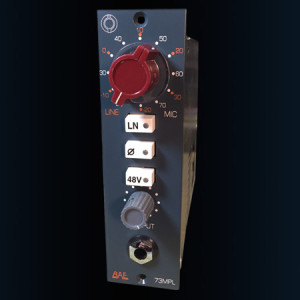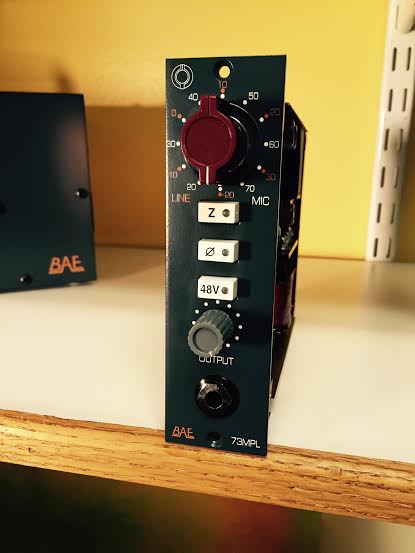New Gear Review: BAE 1073MPL
1073. Among audio engineers, these numbers evoke reverence, tradition, and occasionally, lust.
The presence of these classic modules in so many famous studios, along with the records made with them attest to the lasting appreciation for this fabled design.
Vintage units are highly coveted, and internet forums have only made them go up in value with all the tales of the glorious tone bursting forth from Mr. Neve’s masterpiece.
However, vintage units come with their own set of problems as well: While originally made with the care and consideration necessary to last decades, we are now deep into those decades. And unfortunately the original, manufacturing specs and tolerances didn’t come anywhere close to today’s standards, accounting for a wide variation across original units.
Who can even be sure of how a unit has been stored and treated over the decades? Inconsistent power, hard use, and the very ravages of time and tide can leave one with pedigree, but little else. In our quest for “that” sound, do we have to give up on reliability? BAE insists that we can have both with their latest 500-series mic pre.
Overview
The BAE 1073MPL is in every way a loving copy of the famous vintage Neve 1073 mic preamplifier. Utilizing the same parts as its muse,—not similar, not spec’d but often identical models from the same companies— the 1073MPL is an exercise in simplicity.
Unboxing of the unit showcases its giant, bright red Carnhill St. Ives transformer, and it is a thing of beauty. It is so massive in fact, that the sides of its 500 series casing have holes cut into them to make room!
The only controls on the front panel are the original Marconi knobs for gain, an output trim control, and large, simple buttons reverse polarity, engage phantom power and set the input level to line. Additionally, a high-impedance DI input is available on the front as well. BAE says it will be adding one more control to this unit in later iterations. More on that in a moment.
Opening the device showcases BAE’s quality build. Point-to-point wiring and top-notch workmanship pack the casing. This Class-A, 500-series unit is built like a tank and should last for many years to come. Switches and pots move fluidly and feel solid in use. This is no toy. It’s a professional tool, for discriminating users.
There are no bells and whistles on this device. It is not a swiss army knife. It does one thing, and I’m happy to report that it does it extremely well.
In Use
In use, the 1073MPL was a joy. Coupling it with a Sennheiser MD-421 on vocals for the NY rock act Immaculate Corpses lent weight to the vocal tone and rendered both male and female voices solid and upfront.
Ribbons mics on guitar amps poured out of the speakers like honey. DI bass was thick and meaty. On a mono drum room mic using a Bock 507 (at the lovely Firefly Studios in Canyon Lake, Texas) we captured a gigantic, open sound that all but eliminated the need for time-based fx.
In fact, every source we tried it on ended up with loads of lovely bottom end and tons of depth as well. I opted against using it on a snare drum that was too tubby to begin with, as the added heft only succeeded in weighing it down.
The 1073MPL also comes with a variable input impedance switch with selectable choices of either 300 or 1200 ohms. I’m a huge fan of this option on mic pres and wish more manufacturers would offer it.
Altering the input impedance of a pre-amplifier allows for changes in tonal characteristics without the phase anomalies and amplifier noise of other tone-shaping devices. In other words, you can custom-tailor the pre to more closely match the mic and the situation.
And herein lies my only complaint: With current versions of the MPL, the impedance switch lies of the rear of the unit.
While a pain to reach on a standard rackmount unit, a rear switch on a 500 series piece is unlikely to ever be used due to the difficulty in reaching it. Most recording sessions don’t offer a luxury of time and in the midst of hurried sessions, I can’t pull something apart in order to explore, and more importantly, I shouldn’t have to. I would love to see that switch moved to the front of the unit.
In response to this review and customer feedback, BAE said that it would be adding a switch to the front panel in future iterations and even sent along a picture of an early production unit as proof!
This (temporary) quibble aside, I found the unit to be a huge success overall. In the quest for ultimate tone, the BAE 1073MPL will be an addition to your toolbox worthy of its namesake.
Rich Crescenti is a freelance engineer, producer, teacher, and drummer who works out of several studios in NYC, helping bands make unique recordings. Rich also hits things with sticks for the Brooklyn-based rock band Bugs in the Dark.
Please note: When you buy products through links on this page, we may earn an affiliate commission.








